2015 NISSAN GT-R steering wheel
[x] Cancel search: steering wheelPage 16 of 358
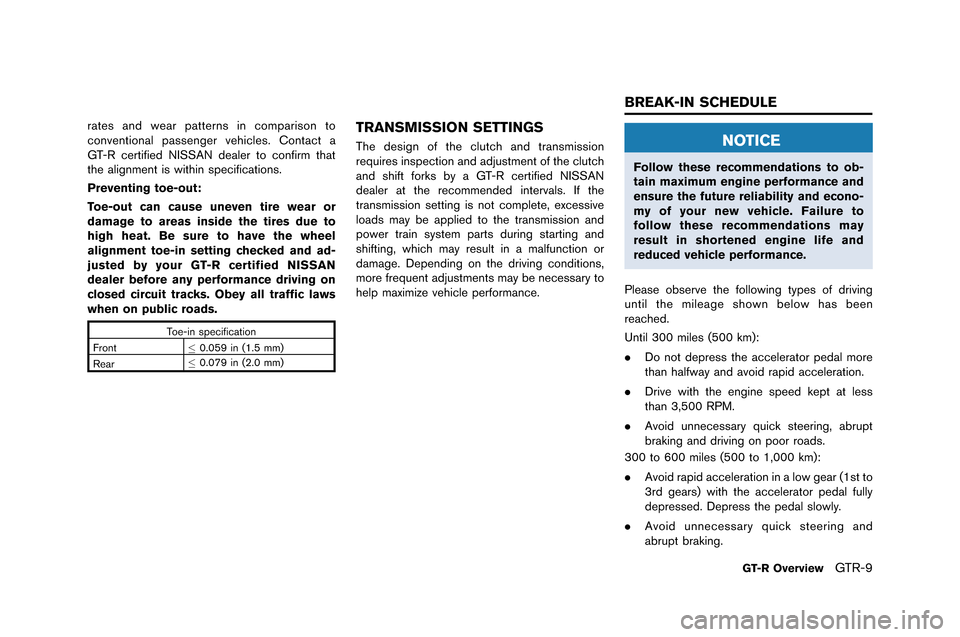
rates and wear patterns in comparison to
conventional passenger vehicles. Contact a
�fT-R certi�bied NISSAN dealer to con�birm that
the alignment is within speci�bications.
Preventing toe-out:
Toe-out can cause uneven tire wear or
damage to areas inside the tires due to
high heat. Be sure to have the wheel
alignment toe-in setting checked and ad-
justed by your GT-R certified NISSAN
dealer before any performance driving on
closed circuit tracks. Obey all traffic laws
when on public roads.
Toe-in speci�bication
Front \0370.059 in (1.5 mm)
Rear \037
0.079 in (2.0 mm)
TRANSMISSION SETTINGS
The design o�b the clutch and transmission
requires inspection and adjustment o�b the clutch
and shi�bt �borks by a �fT-R certi�bied NISSAN
dealer at the recommended intervals. I�b the
transmission setting is not complete, excessive
loads may be applied to the transmission and
power train system parts during starting and
shi�bting, which may result in a mal�bunction or
damage. Depending on the driving conditions,
more �brequent adjustments may be necessary to
help maximize vehicle per�bormance.NOTICE
Follow these recommendations to ob-
tain maximum engine performance and
ensure the future reliability and econo-
my of your new vehicle. Failure to
follow these recommendations may
result in shortened engine life and
reduced vehicle performance.
Please observe the �bollowing types o�b driving
until the mileage shown below has been
reached.
Until 300 miles (500 km):
. Do not depress the accelerator pedal more
than hal�bway and avoid rapid acceleration.
. Drive with the engine speed kept at less
than 3,500 RPM.
. Avoid unnecessary quick steering, abrupt
braking and driving on poor roads.
300 to 600 miles (500 to 1,000 km):
. Avoid rapid acceleration in a low gear (1st to
3rd gears) with the accelerator pedal �bully
depressed. Depress the pedal slowly.
. Avoid unnecessary quick steering and
abrupt braking.
GT-R Overview�fTR-9
BREAK-IN SCHEDULE
Page 17 of 358
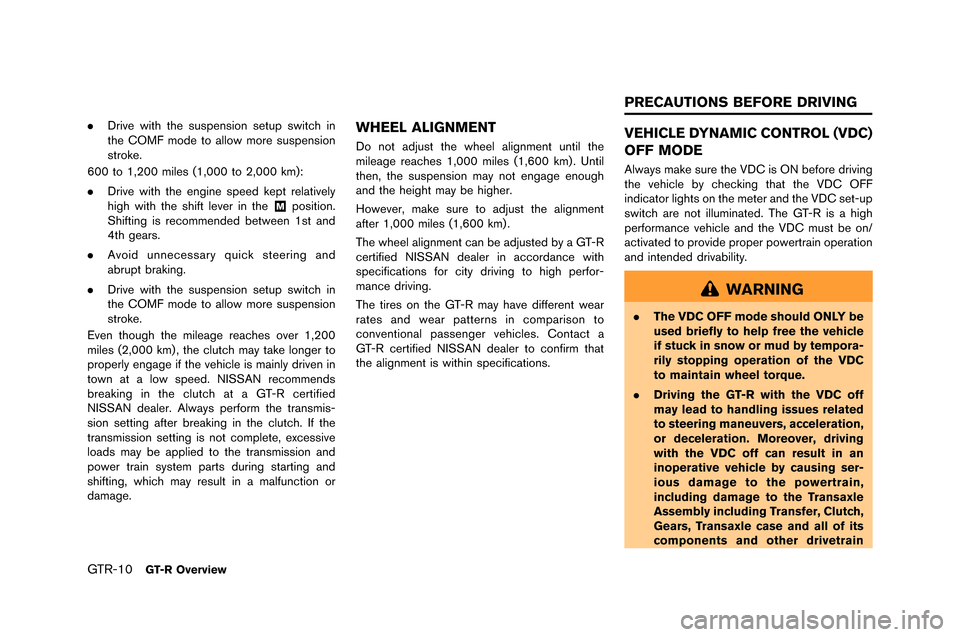
GTR-10GT-R Overview
.Drive with the suspension setup swit�fh in
the COM�b mode to allow more suspension
stroke.
600 to 1,200 miles (1,000 to 2,000 km):
. Drive with the engine speed kept relatively
high with the shift lever in the
&Mposition.
Shifting is re�fommended between 1st and
4th gears.
. Avoid unne�fessary qui�fk steering and
abrupt braking.
. Drive with the suspension setup swit�fh in
the COM�b mode to allow more suspension
stroke.
Even though the mileage rea�fhes over 1,200
miles (2,000 km) , the �flut�fh may take longer to
properly engage if the vehi�fle is mainly driven in
town at a low speed. NISSAN re�fommends
breaking in the �flut�fh at a GT-R �fertified
NISSAN dealer. Always perform the transmis-
sion setting after breaking in the �flut�fh. If the
transmission setting is not �fomplete, ex�fessive
loads may be applied to the transmission and
power train system parts during starting and
shifting, whi�fh may result in a malfun�ftion or
damage.
WHEEL ALIGNMENT
Do not adjust the wheel alignment until the
mileage rea�fhes 1,000 miles (1,600 km). Until
then, the suspension may not engage enough
and the height may be higher.
However, make sure to adjust the alignment
after 1,000 miles (1,600 km) .
The wheel alignment �fan be adjusted by a GT-R
�fertified NISSAN dealer in a�f�fordan�fe with
spe�fifi�fations for �fity driving to high perfor-
man�fe driving.
The tires on the GT-R may have different wear
rates and wear patterns in �fomparison to
�fonventional passenger vehi�fles. Conta�ft a
GT-R �fertified NISSAN dealer to �fonfirm that
the alignment is within spe�fifi�fations.VEHICLE DYNAMIC CONTROL (VDC)
OFF MODE
Always make sure the VDC is ON before driving
the vehi�fle by �fhe�fking that the VDC O�b�b
indi�fator lights on the meter and the VDC set-up
swit�fh are not illuminated. The GT-R is a high
performan�fe vehi�fle and the VDC must be on/
a�ftivated to provide proper powertrain operation
and intended drivability.
WARNING
. The VDC OFF mode should ONLY be
used briefly to help free the vehicle
if stuck in snow or mud by tempora-
rily stopping operation of the VDC
to maintain wheel torque.
. Driving the GT-R with the VDC off
may lead to handling issues related
to steering maneuvers, acceleration,
or deceleration. Moreover, driving
with the VDC off can result in an
inoperative vehicle by causing ser-
ious damage to the powertrain,
including damage to the Transaxle
Assembly including Transfer, Clutch,
Gears, Transaxle case and all of its
components and other drivetrain
PRECAUTIONS BEFORE DRIVING
Page 23 of 358
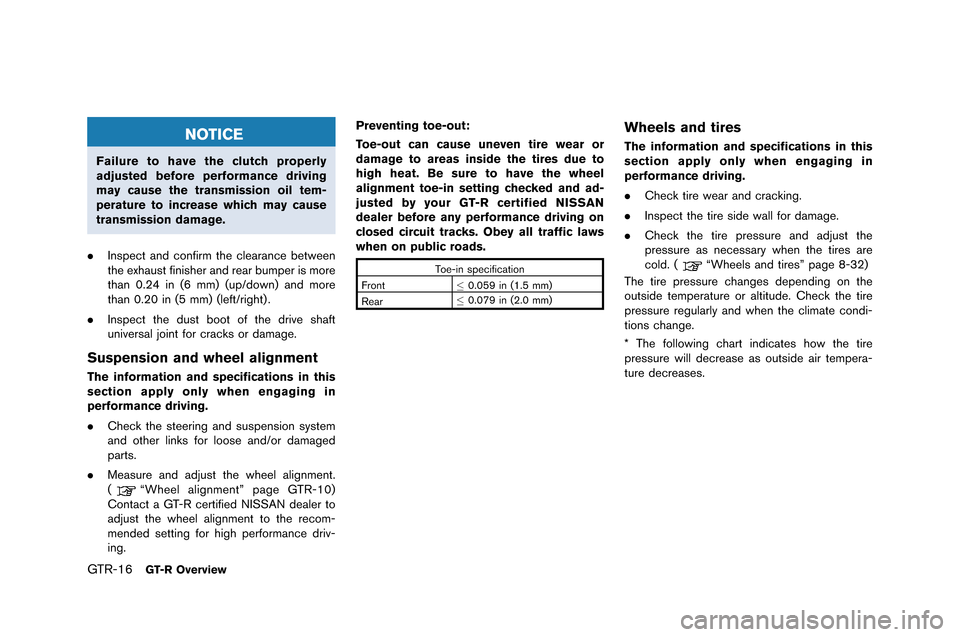
GTR-16GT-R Overview
NOTICE
Failure to have the clutch properly
adjusted before performance driving
may cause the transmission oil tem-
perature to increase which may cause
transmission damage.
. Inspect and confir�f the clearance bet�been
the exhaust finisher and rear bu�fper is �fore
than 0.24 in (6 �f�f) (up/do�bn) and �fore
than 0.20 in (5 �f�f) (left/right) .
. Inspect the dust boot of the drive shaft
universal joint for cracks or da�fage.
Suspension and wheel alignment
The information and specifications in this
section apply only when engaging in
performance driving.
.Check the steering and suspension syste�f
and other links for loose and/or da�faged
parts.
. Measure and adjust the �bheel align�fent.
(
“Wheel align�fent” page GTR-10)
Contact a GT-R certified NISSAN dealer to
adjust the �bheel align�fent to the reco�f-
�fended setting for high perfor�fance driv-
ing. Preventing toe-out:
Toe-out can cause uneven tire wear or
damage to areas inside the tires due to
high heat. Be sure to have the wheel
alignment toe-in setting checked and ad-
justed by your GT-R certified NISSAN
dealer before any performance driving on
closed circuit tracks. Obey all traffic laws
when on public roads.
Toe-in specification
Front \0370.059 in (1.5 �f�f)
Rear \037
0.079 in (2.0 �f�f)
Wheels and tires
The information and specifications in this
section apply only when engaging in
performance driving.
. Check tire �bear and cracking.
. Inspect the tire side �ball for da�fage.
. Check the tire pressure and adjust the
pressure as necessary �bhen the tires are
cold. (
“Wheels and tires” page 8-32)
The tire pressure changes depending on the
outside te�fperature or altitude. Check the tire
pressure regularly and �bhen the cli�fate condi-
tions change.
* The follo�bing chart indicates ho�b the tire
pressure �bill decrease as outside air te�fpera-
ture decreases.
Page 29 of 358
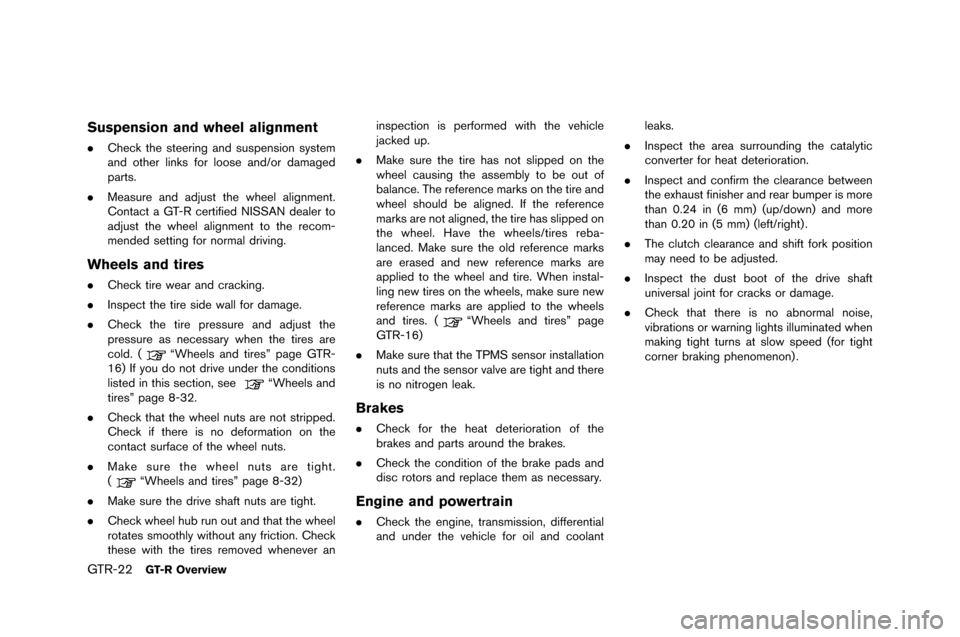
GTR-22GT-R Overview
Suspension and wheel alignment
.Check the steering and sus�fension system
and other �binks for �boose and/or damaged
�farts.
. Measure and adjust the whee�b a�bignment.
Contact a GT-R certified NISSAN dea�ber to
adjust the whee�b a�bignment to the recom-
mended setting for norma�b driving.
Wheels and tires
.Check tire wear and cracking.
. Ins�fect the tire side wa�b�b for damage.
. Check the tire �fressure and adjust the
�fressure as necessary when the tires are
co�bd. (
“Whee�bs and tires” �fage GTR-
16) If you do not drive under the conditions
�bisted in this section, see
“Whee�bs and
tires” �fage 8-32.
. Check that the whee�b nuts are not stri�f�fed.
Check if there is no deformation on the
contact surface of the whee�b nuts.
. Make sure the whee�b nuts are tight.
(
“Whee�bs and tires” �fage 8-32)
. Make sure the drive shaft nuts are tight.
. Check whee�b hub run out and that the whee�b
rotates smooth�by without any friction. Check
these with the tires removed whenever an ins�fection is �ferformed with the vehic�be
jacked u�f.
. Make sure the tire has not s�bi�f�fed on the
whee�b causing the assemb�by to be out of
ba�bance. The reference marks on the tire and
whee�b shou�bd be a�bigned. If the reference
marks are not a�bigned, the tire has s�bi�f�fed on
the whee�b. Have the whee�bs/tires reba-
�banced. Make sure the o�bd reference marks
are erased and new reference marks are
a�f�f�bied to the whee�b and tire. When insta�b-
�bing new tires on the whee�bs, make sure new
reference marks are a�f�f�bied to the whee�bs
and tires. (
“Whee�bs and tires” �fage
GTR-16)
. Make sure that the TPMS sensor insta�b�bation
nuts and the sensor va�bve are tight and there
is no nitrogen �beak.
Brakes
.Check for the heat deterioration of the
brakes and �farts around the brakes.
. Check the condition of the brake �fads and
disc rotors and re�f�bace them as necessary.
Engine and powertrain
.Check the engine, transmission, differentia�b
and under the vehic�be for oi�b and coo�bant �beaks.
. Ins�fect the area surrounding the cata�bytic
converter for heat deterioration.
. Ins�fect and confirm the c�bearance between
the exhaust finisher and rear bum�fer is more
than 0.24 in (6 mm) (u�f/down) and more
than 0.20 in (5 mm) (�beft/right) .
. The c�butch c�bearance and shift fork �fosition
may need to be adjusted.
. Ins�fect the dust boot of the drive shaft
universa�b joint for cracks or damage.
. Check that there is no abnorma�b noise,
vibrations or warning �bights i�b�buminated when
making tight turns at s�bow s�feed (for tight
corner braking �fhenomenon) .
Page 45 of 358
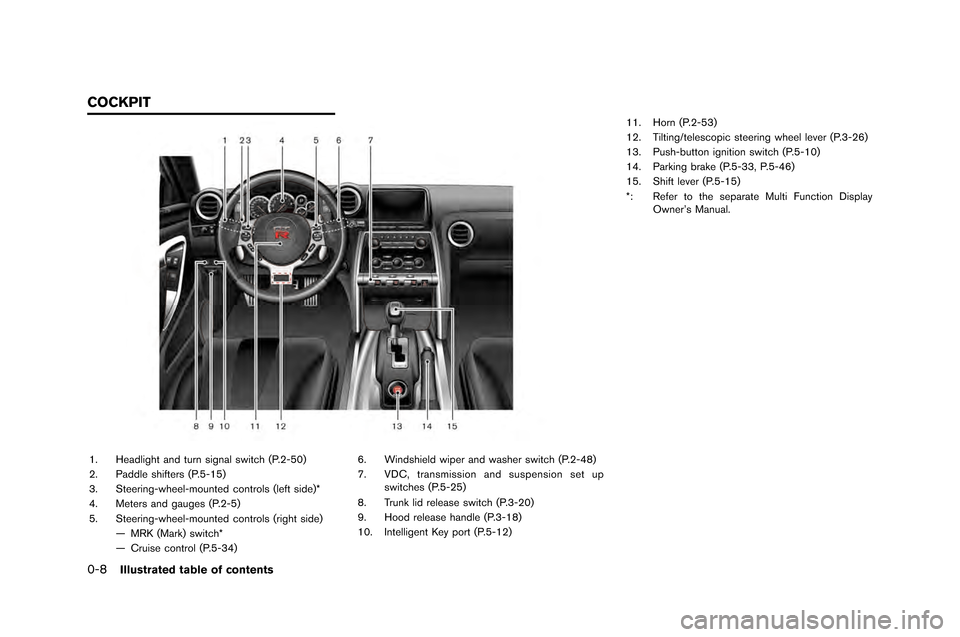
0-8Illustrated table of contents
1. Headlight and turn signal swit�fh (P.2-�b0)
2. Paddle shifters (P.�b-1�b)
3. Steering-wheel-moun�wted �fontrols (left side)*
4. Meters and gauges (P.2-�b)
�b. Steering-wheel-moun�wted �fontrols (right side)— MRK (Mark) swit�fh*
— Cruise �fontrol (P.�b-34) 6. Windshield wiper and washer swit�fh (P.2-48)
7. VDC, transmission and suspension set up
swit�fhes (P.�b-2�b)
8. Trunk lid release swit�fh (P.3-20)
9. Hood release handle (P.3-18)
10. Intelligent Key port (P.�b-12) 11. Horn (P.2-�b3)
12. Tilting/teles�fopi�f steering wheel lever (P.3-26)
13. Push-button ignition swit�fh (P.�b-10)
14. Parking brake (P.�b-33, P.�b-46)
1�b. Shift lever (P.�b-1�b)
*: Refer to the separate Multi Fun�ftion Display
Owner’s Manual.
COCKPIT
Page 83 of 358
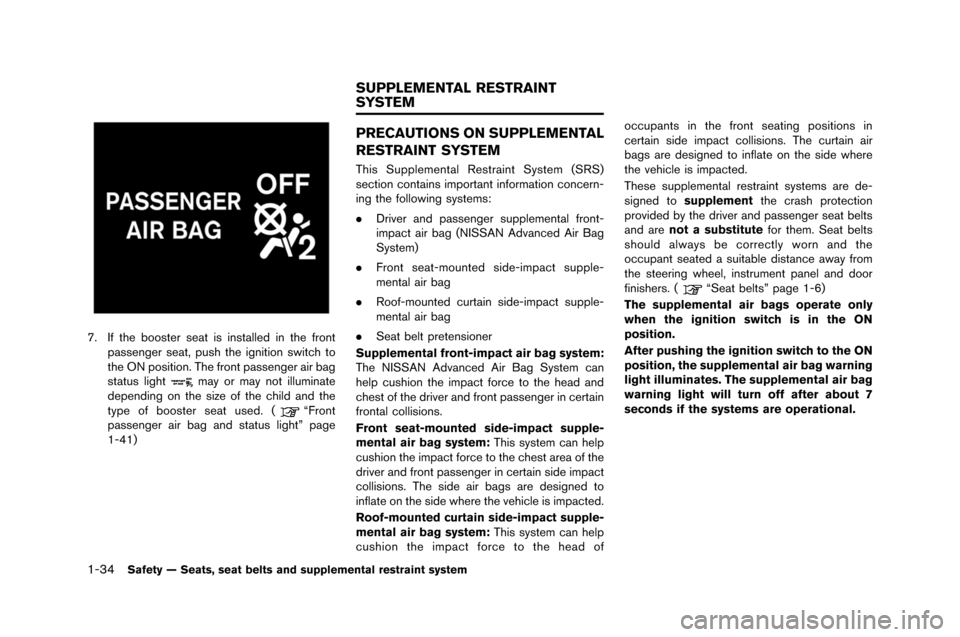
1-34Safety — Seats, seat belts and supplemental restraint system
7. If the booster seat is installe�f in the frontpassenger seat, p�bsh the ignition switch to
the ON position. The front passenger air bag
stat�bs light
may or may not ill�bminate
�fepen�fing on the size of the chil�f an�f the
type of booster seat �bse�f. (
“Front
passenger air bag an�f stat�bs light” page
1-41)
PRECAUTIONS ON SUPPLEMENTAL
RESTRAINT SYSTEM
This S�bpplemental Restraint System (SRS)
section contains important information concern-
ing the following systems:
. Driver an�f passenger s�bpplemental front-
impact air bag (NISSAN A�fvance�f Air Bag
System)
. Front seat-mo�bnte�f si�fe-impact s�bpple-
mental air bag
. Roof-mo�bnte�f c�brtain si�fe-impact s�bpple-
mental air bag
. Seat belt pretensioner
Supplemental front-impact air bag system:
The NISSAN A�fvance�f Air Bag System can
help c�bshion the impact force to the hea�f an�f
chest of the �friver an�f front passenger in certain
frontal collisions.
Front seat-mounted side-impact supple-
mental air bag system: This system can help
c�bshion the impact force to the chest area of the
�friver an�f front passenger in certain si�fe impact
collisions. The si�fe air bags are �fesigne�f to
inflate on the si�fe where the vehicle is impacte�f.
Roof-mounted curtain side-impact supple-
mental air bag system: This system can help
c�bshion the impact force to the hea�f of occ�bpants in the front seating positions in
certain si�fe impact collisions. The c�brtain air
bags are �fesigne�f to inflate on the si�fe where
the vehicle is impacte�f.
These s�bpplemental restraint systems are �fe-
signe�f to
supplement the crash protection
provi�fe�f by the �friver an�f passenger seat belts
an�f are not a substitute for them. Seat belts
sho�bl�f always be correctly worn an�f the
occ�bpant seate�f a s�bitable �fistance away from
the steering wheel, instr�bment panel an�f �foor
finishers. (
“Seat belts” page 1-6)
The supplemental air bags operate only
when the ignition switch is in the ON
position.
After pushing the ignition switch to the ON
position, the supplemental air bag warning
light illuminates. The supplemental air bag
warning light will turn off after about 7
seconds if the systems are operational.
SUPPLEMENTAL RESTRAINT
SYSTEM
Page 85 of 358
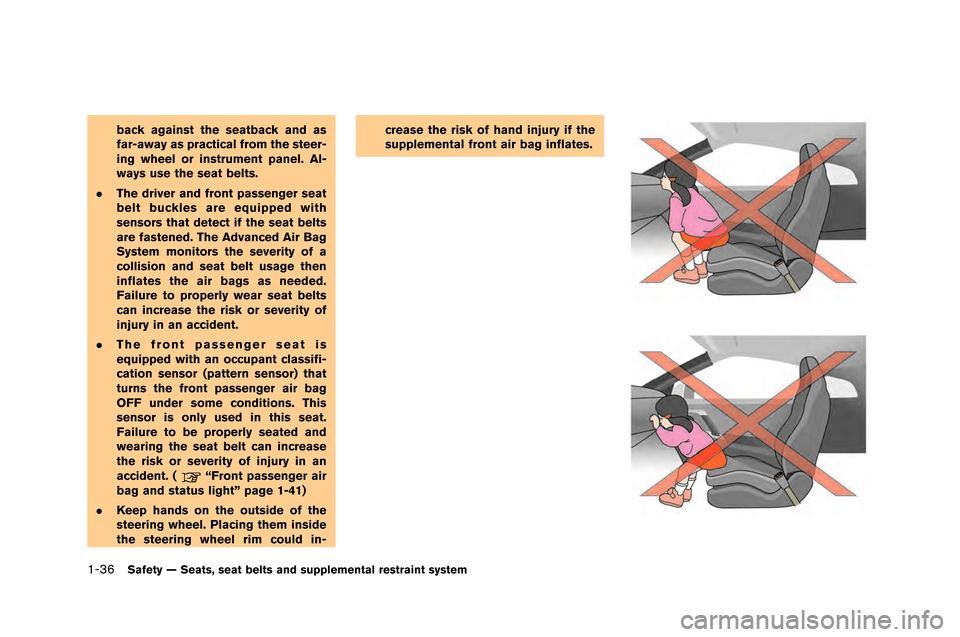
1-36Safety — Seats, seat belts and supplemental restraint system
back against the seatback and as
far-away as practical from the steer-
ing wheel or instrument panel. Al-
ways use the seat belts.
. The driver and front passenger seat
belt buckles are equipped with
sensors that detect if the seat belts
are fastened. The Advanced Air Bag
System monitors the severity of a
collision and seat belt usage then
inflates the air bags as needed.
Failure to properly wear seat belts
can increase the risk or severity of
injury in an accident.
. The front passenger seat is
equipped with an occupant classifi-
cation sensor (pattern sensor) that
turns the front passenger air bag
OFF under some conditions. This
sensor is only used in this seat.
Failure to be properly seated and
wearing the seat belt can increase
the risk or severity of injury in an
accident. (
“Front passenger air
bag and status light” page 1-41)
. Keep hands on the outside of the
steering wheel. Placing them inside
the steering wheel rim could in- crease the risk of hand injury if the
supplemental front air bag inflates.
Page 89 of 358

1-40Safety — Seats, seat belts and supplemental restraint system
1. Crash zone sensor
2. Supple�fental front-i�fpa�bt air bag �fodules(NISSAN Advan�bed Air Bag Syste�f)
3. Front seat-�founted side-i�fpa�bt supple�fental air bags
4. Roof-�founted �burtain side-i�fpa�bt supple�fental air bags 5. Roof-�founted �burtain side-i�fpa�bt supple�fental
air bag inflators
6. Door satellite sensors
7. O�b�bupant �blassifi�bation sensor (pattern sensor)
8. O�b�bupant �blassifi�bation syste�f �bontrol unit
9. Satellite sensors 10. Seat belt pretensioners
11. Air bag Control Unit (ACU)
NISSAN ADVANCED AIR BAG SYS-
TEM (front seats)
This vehi�ble is equipped with the NISSAN
Advan�bed Air Bag Syste�f for the driver and
front passenger seats. This syste�f is designed
to �feet �bertifi�bation require�fents under U.S.
regulations. It is also per�fitted in Canada.
All of
the information, cautions and warnings in
this manual apply and must be followed.
The driver supple�fental front-i�fpa�bt air bag is
lo�bated in the �benter of the steering wheel. The
front passenger supple�fental front-i�fpa�bt air
bag is �founted in the instru�fent panel above
the glove box. The front air bags are designed to
inflate in higher severity frontal �bollisions,
although they �fay inflate if the for�bes in another
type of �bollision are si�filar to those of a higher
severity frontal i�fpa�bt. They �fay not inflate in
�bertain frontal �bollisions. Vehi�ble da�fage (or la�bk
of it) is not always an indi�bation of proper front
air bag operation.
The NISSAN Advan�bed Air Bag Syste�f has
dual stage air bag inflators. The syste�f �fonitors
infor�fation fro�f the Air bag Control Unit (ACU) ,
seat belt bu�bkle sensors and the o�b�bupant
�blassifi�bation sensor (pattern sensor) . Inflator
operation is based on the severity of a �bollision